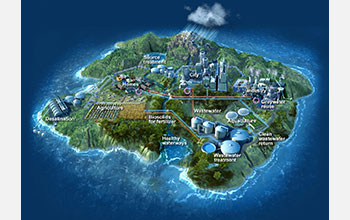Multimedia Gallery
The urban water cycle (Image 1)
Urban areas, where 80 percent of the U.S. population lives, are engines of economic growth, but they need an increasing amount of energy, agricultural products and clean drinking water – one of society’s greatest engineering achievements. Making clean water accessible and sustainable for future generations requires investments in new ideas and systems for water treatment, distribution, reuse and recovery. This bird’s eye view of an engineer’s fantasy water flow between homes, industry and farming foreshadows inventive flows of the future. Clean water technologies and systems could make an efficient engineered water cycle more than a reverie.
In this illustration, desalination facilities treat salt water from the ocean (green arrows) that goes for home and agricultural use. Clean, drinkable water (blue arrows) flows for human consumption and industry, where it is reused as greywater (purple arrows) and sent to water resource recovery plants (red arrows). From there, biosolids that result from wastewater treatment become fertilizer (red arrows), while treated water goes back into the system to slake the thirst of plants, animals and people alike (blue arrows). [View image without labeling Here.]
To learn more about this research, see the NSF News From the Field story Cleaner Water, Clearer Future: Engineering new water tech. (Date image taken: 2016; date originally posted to NSF Multimedia Gallery: Jan. 10, 2018)
Credit: Nicolle R. Fuller, Sayo-Art LLC
Images and other media in the National Science Foundation Multimedia Gallery are available for use in print and electronic material by NSF employees, members of the media, university staff, teachers and the general public. All media in the gallery are intended for personal, educational and nonprofit/non-commercial use only.
Images credited to the National Science Foundation, a federal agency, are in the public domain. The images were created by employees of the United States Government as part of their official duties or prepared by contractors as "works for hire" for NSF. You may freely use NSF-credited images and, at your discretion, credit NSF with a "Courtesy: National Science Foundation" notation.
Additional information about general usage can be found in Conditions.
Also Available:
Download the high-resolution JPG version of the image. (2.4 MB)
Use your mouse to right-click (Mac users may need to Ctrl-click) the link above and choose the option that will save the file or target to your computer.



